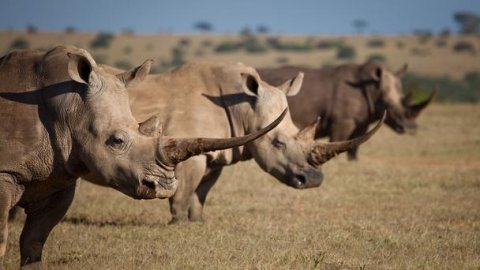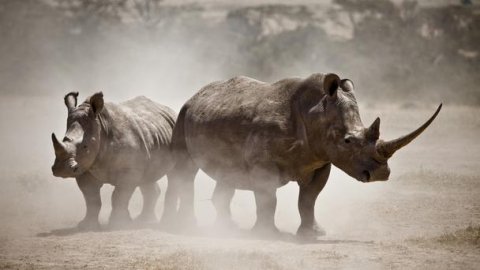Rhino poaching driving black rhino and white rhino to near extinction
Located 160km north of Nairobi, Solio Reserve is the premier place in Africa to see black and white rhino in the wild, but these precious animals are at the heart of a bloody poaching battle. The previous night, armed rangers who patrol the park’s 48km-long electric fence saw three men with tools and guns try to enter the reserve – and the previous month they discovered poachers cutting a hole in the fence near where a pair of cheetah makes their den. On both occasions, the rangers won out, but it was an unsettling reminder that the battle for the survival of one of Africa’s most endangered species is far from won. The problem is so rampant in central Kenya, where breeders have made in-roads into breeding rhinos in captivity on private reserves, that during the monthly full moon cycle, when poachers are not reliant on torches or headlamps for light, the rhinos need to be protected 24 hours a day. Tragically, in 2012 Solio lost at least 12 out of around 220. “Solio represents the heartbeat of rhino conservation in Kenya,” said Felix Patton, the reserve’s rhino monitoring coordinator. “Because of that, the poaching pressure is ever present – so there is a need to bring in more income to sustain the rhinos’ security and habitat. More importantly, though, we need to change the poacher’s attitudes – because the real value of rhino horn is completely misunderstood. It is more valuable on a rhino – both for animal conservation and tourism – than it is hanging on somebody’s wall.” Despite having survived as a species for at least 50 million years, black and white rhino have been hunted to near-extinction because of their horns. At its peak in the 1970s, poaching was so rampant that rhino numbers in Kenya crashed by 90% from 20,000 to 1,500, and by the early 1990s, only 400 were left in the country. Rhino horn now rivals the price of gold on the black market and is trafficked to Yemen, where the horns are fashioned into handles for prized djambia daggers, and to the Far East, where China is the biggest market. Here, rhino horn can change hands for as much as $60,000 per kilogram, and it is used as an ingredient in medicines and traditional remedies to reduce fever. Stranger still, rhino horn is increasingly offered as a cocaine-like powder to guests at exclusive VIP parties in China and Vietnam as a superstitious way to ward off morning-after hangover symptoms. The major issue is that the penalties for poaching are insignificant (from as little as 4,000 Kenyan shillings) and poachers work in complex networks comparable to drug cartels that are very hard to police. However, despite the heavy losses and a lack of governmental help in clamping down on poachers, Solio now operates the world’s most progressive rhino conservation scheme and has become a blueprint for East Africa. It began back in 1966, when Colorado-born mine magnate Courtland Parfet bought the ranch, an area of grassland mainly for grazing beef cattle. At the time, it was also used as a habitat for a range of wildlife, including buffalo, zebra, gazelles and leopards, which frequently strayed onto the farmland from the neighbouring grasslands. In 1970, answering an SOS call from Kenya’s Wildlife and Conservation Management Department, a forerunner to the Kenya Wildlife Service, Parfet was asked if he could temporarily look after the country’s last remaining wild black rhinos while a permanent refuge and sustainable habitat was found for them. Over the next decade, Solio was called on again and again by the government, and, by 1980, the reserve was home to 27 rhinos. In the 1990s, the first white rhinos were imported from South Africa and the results of the breeding programme saw the animals transferred to other reserves in Kenya, including Lake Nakuru National Park, Sweetwaters Game Reserve and Lewa Downs Conservancy. Run by the Carr-Hartleys today – a Kenyan family that has been involved in the East African wildlife scene for three generations – Solio now has 71 black rhinos and 150 white rhinos, the highest density in East Africa. Indeed, the park’s management has trans-located 100 black and 60 white rhinoceros to other parts of Africa, including six to Uganda and three to Malawi. Naturally, success breeds its own problems. The increase in the number of animals on the reserve has led to the rhinos’ main food source – the leaves from the acacia-native whistling thorn – being almost eaten out. And Kenya’s farmlands are edging ever closer to the park’s boundaries as farmers seek new pastures for their cattle to graze on. To combat this, the reserve is trying to raise awareness and necessary funds by encouraging tourists to visit. It is completely safe – poachers only come after nightfall – and Solio is now home to a dedicated luxury lodge with six rooms, while game drives are readily available to see the park’s most famous residents up close. “The next year or two will see big developments here,” Patton said. “Tourist revenue should be increased; there are rhinos to be sold or trans-located; and the reserve is to be extended by a further 15sqkm.” Plans are also afoot, according to Patton, to install an expensive high-tech electric perimeter fence with an intruder alarm. “Although there are many financial and political problems to overcome – not least in the misunderstandings about rhino habitat and the practical uses of rhino horn – it really is a privilege to work at the vanguard of rhino conservation in Kenya.”







Recent comments